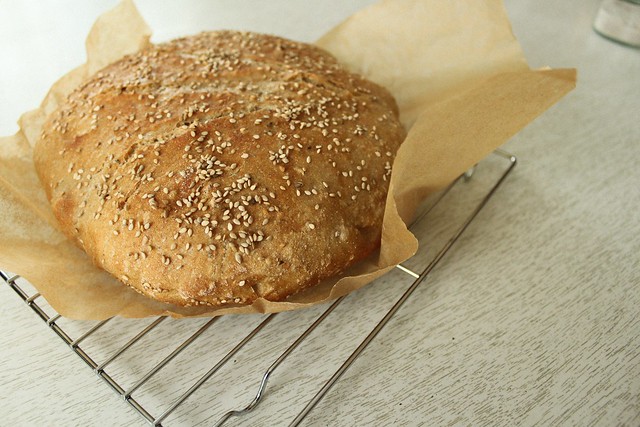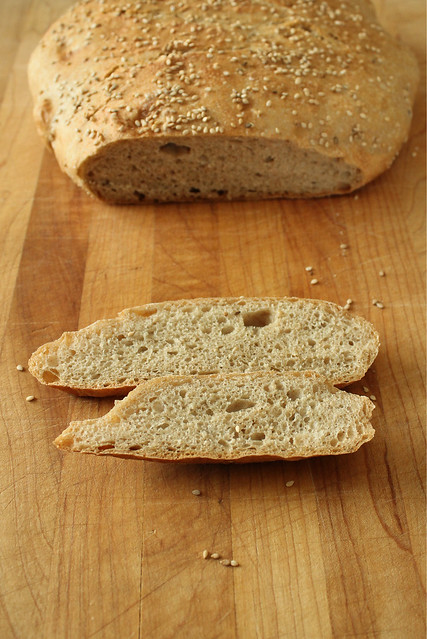Over breakfast this morning, I was paging through Maria Speck's Ancient Grains for Modern Meals. Ordinarily I read cookbooks cover to cover, starting at the beginning and gradually making my way through each recipe, story, and picture in sequence as the author intended. Maybe time is so short for me lately that I bucked my trend and just headed for the guts and the pictures, making a moment or two to think about my meals for the week between pureed mouthfuls fed to the baby bird. How I happened to see the recipe for Floating Sesame Loaf is a mystery. I wasn't perusing the book for bread to be sure, but the name alone conjured such an image that we endured the little baby bird squawking for a few minutes when I read the recipe twice through.
Could it be that this bread could work? It seemed to be an impossibly wet loaf, spending some time rising in cold tap water before maneuvering into the oven. Still shy of more sourdough since last weeks fail (I did start more loaves today however), we kind of needed some bread today, and I am not one to see a recipe like this without immediately stopping everything to give it a shot.
My first impressions were that this dough was beyond unruly; I tried hard not to add too much additional flour, using a bench scraper to work it into a rough round and transfer it quickly to a pot of cold water. It stays there for 15-30 minutes, enough time for the dough to rise to the top of the water. Maria Speck says the dough when plucked from the water and allowed to drain in your hands should feel like cold clay, and it did. I fought my impulse to let it bench rest for a short time and followed the recipe to the letter: quickly and without much flour forming it into a round and plopping it down on some parchment to rise for another 20 minutes. In retrospect, I could have easily added a little extra flour to make things easier on myself - but I can't complain with the lightness of the finished bread.
I could tell that it wasn't going to be a tall loaf, but I wasn't sure what more I could expect. I used Lonesome Stone Milling wheat bread flour (12% protein), I'd say it was kind of a "white whole wheat" if I were trying to explain the flour. That flour has an excellent flavor, and a few tablespoons of toasted sesame, a teaspoon each of sugar and some commercial yeast were all the simple ingredients. I baked it at 425 as directed, but I baked it in a cast iron pot since that is what I'm comfortable using. I transferred the loaf parchment and all to the pot and baked it 20 minutes with the lid on and 10 without.
I was pretty good about letting it cool to room temperature. It was soft, and smelled so sweet - despite the minuscule amount of sugar in it - and it was nearly impossible not to want to eat it warm with honey and butter. The crumb was perfect sandwich style crumb, and really I couldn't believe a straight yeast bread could happen so quickly, without kneading, and with fairly little mess. I think with a little practice, this technique could prove to be a good experiment with sourdough - but maybe I'll wait until I can carve out a little more devoted time to myself before embarking on that.
I won't forget about this bread, risen in water, relaxed (tricked?) into gluten formation by sheer science with no real help from me. Tomorrow morning, we've already decided to turn it into french toast which I'm sure will be great with some extra sesame sprinkled on before griddling.
I've decided that I can't print the floating bread recipe here, I wasn't finding too much information about it on the Internet, and Maria's book is so lovely it's worth finding a copy and reading about it in her words. If you have tried a similar type of bread that spends some time rising in water, please drop me a line and let me know! I'm really curious why there isn't a whole lot of information online... I'm planning to scour the library for obscure German baking books and doing some more research 1980's style.
I've decided that I can't print the floating bread recipe here, I wasn't finding too much information about it on the Internet, and Maria's book is so lovely it's worth finding a copy and reading about it in her words. If you have tried a similar type of bread that spends some time rising in water, please drop me a line and let me know! I'm really curious why there isn't a whole lot of information online... I'm planning to scour the library for obscure German baking books and doing some more research 1980's style.





